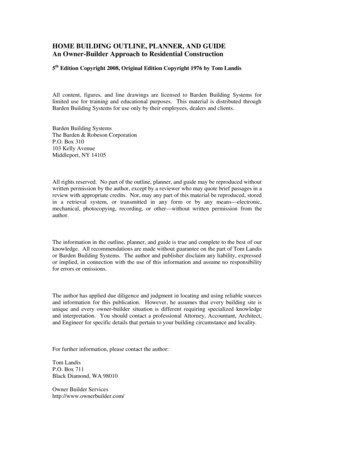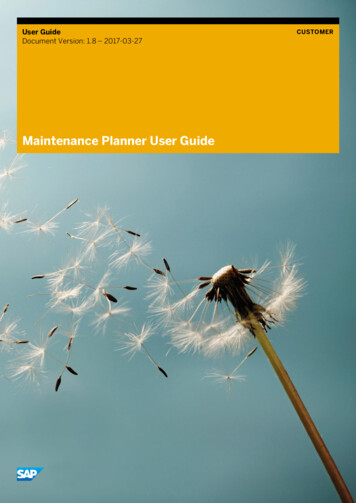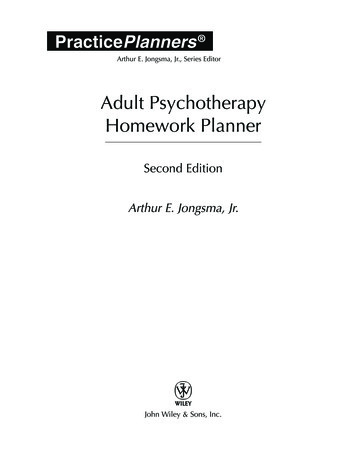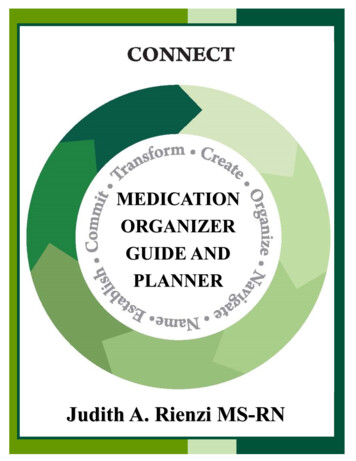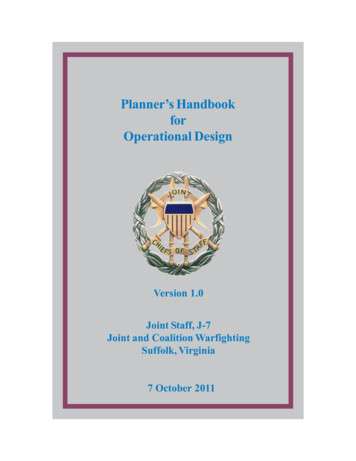
Transcription
Planner’s HandbookforOperational DesignVersion 1.0Joint Staff, J-7Joint and Coalition WarfightingSuffolk, Virginia7 October 2011
DEPUTY DIRECTOR, J-7, JOINT STAFFJOINT AND COALITION WARFIGHTING116 LAKE VIEW PARKWAYSUFFOLK, VA 23435-2697MESSAGE TO JOINT WARFIGHTERSMilitary operations, particularly those involving combat, have always been tough.However, today’s operational environment challenges us even more with increasinglycomplex and interconnected geopolitical circumstances, the blurring of the lines betweencombatants and civilians, rapid technology change, and adaptive adversaries who possessa wider range of capabilities and an ideological “home-field” advantage. Strategic andoperational-level problems that cannot be solved with military ways and means alone arethe norm rather than the exception.In his October 2009 Vision for a Joint Approach to Operational Design, General JamesMattis observed that standard planning processes have served us well to this point.However, he wrote that commanders and staffs generally tend to use these processessomewhat mechanically, with a focus on procedure and details that often obscure theimportance of the underlying creative process. The complex nature of current andprojected challenges requires that critical thinking, creativity, foresight, andadaptability—rather than strict reliance on methodical steps—must become routine.To support and improve detailed planning, Army and Marine Corps design-relatedinitiatives have been exploring methods that use critical and creative thinking tounderstand and describe ill-defined problems and visualize broad approaches to solvethem. The joint community has been considering the potential beneficial effect of thiseffort on joint doctrine, training, and professional military education, and is codifying keydesign-related ideas in JP 3-0, Joint Operations, and JP 5-0, Joint Operation Planning.Although not authoritative, this handbook describes design ideas in the context of jointdoctrine’s current operational design and joint operation planning process. These ideasshould stimulate the joint community’s thinking to help refine operational design andimprove joint doctrine, education, and training. Your perspectives are important to us,and I encourage you to engage in this examination. We welcome your specific critique ofthe ideas presented in this handbook, and ask that you share your own value-added ideasfor incorporation in emerging joint doctrine.FREDERICK S. RUDESHEIMMajor General, U.S. ArmyDeputy Director, J-7, Joint Staff,Joint and Coalition Warfighting
PREFACE1.ScopeThis handbook describes operational design and its interaction with joint operationplanning. It is based partly on joint doctrine contained in JP 5-0, Joint OperationPlanning, and JP 2-01.3, Joint Intelligence Preparation of the Operational Environment,but it provides more details on operational design than currently exist in thesepublications. The handbook also highlights “best practices” derived from Service, joint,and multinational operations and joint exercises. In particular, this handbook increasesthe depth of discussion on operational design by incorporating new design-related ideasdeveloped and refined in Service and joint academic institutions during the past threeyears.2.PurposeThis handbook has two primary purposes:a. The first is to provide useful details to commanders and planners on jointoperational design and its interaction with the joint operation planning process.b. The second is to stimulate thinking about the best ways to incorporate new,design-related ideas into emerging joint doctrine, training, and education. This handbookprovides a platform the joint community can use to examine and debate design issues andestablish a common frame of reference for collaboration on assimilating value-addedideas.3.DevelopmentThis handbook fulfills a commitment to develop this product as stated in theUSJFCOM Commander’s 6 Oct 09 memorandum, Vision for a Joint Approach toOperational Design and the Joint Warfighting Center’s 20 Sep 10 Pamphlet 10, Design inMilitary Operations. The USJFCOM Joint Doctrine Division developed this handbookbased on a variety of sources, including the following:a. Design-related work primarily by the Army and Marine Corps and reflected in avariety of non-doctrinal papers and doctrine products;b. The exploration of design in the classroom by the Joint Advanced WarfightingSchool (JAWS) at the Joint Forces Staff College and the Army’s School of AdvancedMilitary Studies (SAMS) at Fort Leavenworth;c. An extensive array of articles in professional journals reflecting the ideas ofpractitioners across the joint community;i
Prefaced. Discussions during the CAPSTONE and PINNACLE senior executive educationprograms as well as observations during joint operations and training exercises.4.ApplicationThis handbook is aimed at joint force planners, Service/functional componentplanners, and others involved in planning. The handbook is not approved doctrine, but itis consistent with current joint doctrine. It is a non-authoritative product that can assistcommanders and staffs to design, plan, and execute joint operations. Users shouldconsider the potential benefits and risks of using this information in actual operations.5.Contact InformationWe encourage comments and suggestions on this important topic. The DeputyDirector, J-7, Joint Staff, Joint and Coalition Warfighting points of contact are LTC JimDiCrocco, 757-203-6243, james.dicrocco@hr.js.mil; and Mr. Rick Rowlett, 757-2036167 (DSN 668), ricky.rowlett.ctr@hr.js.mil.iiPlanner’s Handbook for Operational Design
TABLE OF CONTENTSCHAPTER IOVERVIEW Introduction . I-1Executive Summary . I-3Conclusion . I-7CHAPTER IITHEORETICAL UNDERPINNINGS OF OPERATIONAL DESIGN Introduction .II-1Critical and Creative Thinking .II-2Systems Theory .II-4The Nature of Problems .II-7Relevant Constructs from Military Theory .II-9Combining the Theories .II-11CHAPTER IIIINTRODUCTION TO OPERATIONAL ART AND OPERATIONAL DESIGN Introduction . III-1Operational Art . III-1Operational Design . III-3The Role of the Commander . III-8Depicting the Methodology . III-10CHAPTER IVDEPICTING THE OPERATIONAL ENVIRONMENT Introduction . IV-1Depicting the Operational Environment . IV-2CHAPTER VUNDERSTANDING THE OPERATIONAL ENVIRONMENT AND THEPROBLEM Introduction . V-1Critical Thinking . V-2Establishing a Baseline . V-4The End State . V-5Conditions and the Desired System . V-7Understanding the Problem . V-9The Environmental Forces at Work . V-13iii
Table of Contents Describing the Problem . V-16CHAPTER VITHE OPERATIONAL APPROACH Introduction . VI-1The Operational Approach . VI-2Publishing the Operational Approach . VI-6CHAPTER VIITHE INTERACTION OF OPERATIONAL DESIGN AND PLANNING Introduction . VII-1Planning Initiation, Mission Analysis, and Operational Design . VII-2Operational Design Elements and the Planning Process . VII-6Detailed Planning . VII-7Assessment . VII-9CHAPTER VIIIORGANIZING FOR OPERATIONAL DESIGN AND PLANNING Introduction . VIII-1The Joint Force J-5 . VIII-2The Joint force J-2 . VIII-6The Design Team . VIII-9CHAPTER IXOPERATIONAL DESIGN AND PLANNING DURING EXECUTION Introduction . IX-1Execution . IX-1Planning during Execution . IX-2Operational Design during Execution . IX-4Reframing and Redesign . IX-6CHAPTER XOPERATIONAL IMPLICATIONS AND CONCLUSION ivIntroduction . X-1Doctrine . X-1Education and Training . X-2Conclusion . X-3Planner’s Handbook for Operational Design
Table of ContentsAPPENDIXESABCDDVisualizing the Operational Environment . A-1Operational Design Elements .B-1Thinking Critically about Critical Thinking .C-1Historical Examples of Operational Design . D-1References . E-1GLOSSARYPart I Abbreviations and Acronyms . GL-1Part II Terms and Definitions . A Taxonomy of Learning .II-3Understanding the Problem .II-7Joint Operation Planning Process . III-5The Balance of Operational Design and JOPP . III-5Design Components . III-11The Operational Environment . IV-2Depicting System Relationships . IV-4Identifying Relevant Relationships . IV-5Identifying Centers of Gravity . IV-6Narcotics Network Analysis . IV-7Afghanistan Counterinsurgency Dynamics . IV-9A Critical Thinking Model . V-3Describe the Problem . V-10The Environment’s Forces at Work . V-14The Operational Approach . VI-1Operational Approach – The Basics . VI-2Line of Operations and Line of Effort . VI-4Operational Approach – an Example . VI-7Operational Approach – Another Example . VI-7Joint Operation Planning Process . VII-3Mission Analysis Activities . VII-5Elements of Operational Design .VII-7The Balance of Operational Design and JOPP .VII-8Assessment Levels and Measures . VII-11Notional Joint Task Force J-5 Organization . VIII-2Joint Planning Group Composition . VIII-3Basic Planning Team Model . VIII-4Basic Working Group Model . VIII-5Notional Joint Task Force J-2 Organization . VIII-6Planning during Execution . IX-3Staff Interaction Supporting Decision-Making . IX-4v
Table of B-2B-3C-1viNarcotics Network Analysis – 1 . A-2Narcotics Network Analysis – 2 . A-3Narcotics Network Analysis – 3 . A-4Narcotics Network Analysis – 4 . A-5Narcotics Network Analysis – 5 . A-6Narcotics Network Analysis – 6 . A-7Political Subsystems . A-9Military Subsystems . A-10Economic Subsystems . A-11Social Subsystems . A-12Infrastructure Subsystems . A-13Information Subsystems . A-14Characteristics of Centers of Gravity .B-2Examples of Centers of Gravity .B-4Direct and Indirect Approach .B-6A Critical Thinking Model .C-7Planner’s Handbook for Operational Design
CHAPTER IOVERVIEWDesign does not replace planning, but planning is incomplete without design.The balance between the two varies from operation to operation as well aswithin each operation. Design helps the commander provide enough structureto an ill-structured problem so that planning can lead to effective action towardstrategic objectives. Likewise, design is not new to joint doctrine, but I believewe can substantially improve doctrine’s current treatment and change JPMEand joint training accordingly to the benefit of current and future leaders at alllevels.General James MattisVision for a Joint Approach to Operational Design,6 October 20091.Introductiona. This handbook focuses on operational design and related aspects of jointoperation planning within strategic and operational-level context. The handbook isrelevant to joint force commanders (JFC), joint force Service and functional componentcommanders, and their respective staffs. However, the staff is the intended targetaudience, especially those involved in planning joint operations.b. Dealing with ill-structured problems has been at the core of a multi-year“design” initiative spearheaded by the Army and Marine Corps. These Servicesexamined this challenge over a three-year period during a series of strategic andoperational-level seminars and wargames. These included UNIFIED QUEST, theArmy’s annual U.S. Code, Title 10, Future Warfare Study Plan and capstone wargame,and numerous Marine Corps seminars.The work has focused on improvingcommanders’ and staff’s abilities to use critical and creative thinking to help themunderstand the fundamental nature of a complex military problem; to design a broadapproach to achieve objectives and accomplish the mission; and to determine if, when,and how to change that approach when circumstances change. The Army and MarineCorps have embedded key ideas in their planning doctrine and the joint community isdoing the same in Joint Publication (JP) 5-0, Joint Operation Planning, and other keyJPs.c. Operational design is the conception and construction of the framework thatunderpins a campaign or major operation plan and its subsequent execution.1 Thejoint operation planning process (JOPP) is an orderly, analytical process that consists ofa logical set of steps to analyze a mission, select the best course of action, and produce ajoint operation plan or order.2 Early operational design focuses on conceptual planning.It occurs within JOPP to produce the eventual plan or order that drives the joint1Joint Publication (JP) 1-02, Department of Defense Dictionary of Military and Associated Terms.JP 5-0, Joint Operation Planning, August 2011, p. GL-12. JOPP is essentially the same set of steps usedin Service-specific planning processes. See JP 5-0 Chapter IV.2I-1
Chapter Ioperation, but also continues throughout execution. Operational design’s initial focus ison helping the JFC visualize the operational environment, understand the problem thatmust be solved, and develop a broad operational approach that can create the desired endstate. JOPP converts the broad approach to a detailed solution in an operation plan(OPLAN) or operation order (OPORD). The box below highlights the potential value ofincorporating new design-related ideas in joint doctrine, training, and education.What’s the Potential Value-added? Increased emphasis on the role of the commander. Enhanced dialogue between commanders and staffs across levels. Deeper (and earlier) understanding of the operational environment. Better understanding of the problem and its root causes. Better guidance to drive detailed planning. Shared visualization of the flow of the operation. Enhanced adaptability to changes in the environment or problem. Expanded role of the assessment process.d. What is the relationship of generic design to joint doctrine’s operationaldesign?(1) In general, the terms have been related but not identical. The focus ofdiscussion and writing on design during the past three years has been on the critical andcreative thinking and learning required to understand complex operational environmentsand ill-defined problems facing the commander. Such understanding should facilitateearly development of a broad operational approach that can guide the more detailedplanning process. Operational design is a construct that joint doctrine has used since2002 to encompass various elements of operational design (previously called facets ofoperational art) that planners have applied to develop a framework for a campaign ormajor operation.3 However, joint doctrine’s explanation of operational design hasfocused more on the details of each element (such as center of gravity analysis) than onthe critical and creative thinking that must precede the elements. The term operationalart, described later, embodied the creative and visionary application of the elements.(2) Army and Marine Corps doctrine publications provide Service-specificviews of design, which can apply at all levels as a generic critical and creativemethodology.4 To distinguish between joint and Service planning, however, jointdoctrine uses the term operational design to encompass practices at the operational3JP 5-00.1, Joint Doctrine for Campaign Planning, 25 January 2002. This JP first defined operationaldesign as “The key considerations used as a framework in the course of planning for a campaign or majoroperation.”4See Army Field Manual 5-0, The Operations Process, and Marine Corps Warfighting Publication 5-1,Marine Corps Planning Process.I-2Planner’s Handbook for Operational Design
Overviewlevel by joint force commanders5 and their staffs. The joint force’s Service andfunctional components participate in joint operation planning, so it is important that thosecommanders and staffs be able to adjust to nuances of operational design and JOPP.(3) JP 5-0, Joint Operation Planning, is joint doctrine’s authoritative source forjoint operation planning and operational design. The community’s recent work todescribe the importance of design’s early critical and creative thinking has helpedrefocus joint doctrine’s operational design. The new (August 2011) JP 5-0 nowincorporates the generic design methodology as a way to improve the JFC’s and staff’searly understanding through what some call “conceptual planning” before planners movetoo quickly to detailed planning.6 The intent for this handbook is to provide sufficientadditional detail so that JFCs and staffs can better understand design methodologyin the context of operational design and JOPP.Note to the ReaderIn essence, the above explanation conveys that joint doctrine’s operationaldesign has embraced and subsumed design’s philosophy and generalmethodology. Therefore, the remainder of the handbook uses the two termsinterchangeably (to mean operational design) except when referring specificallyto the historical development of the Services’ design ideas or underlying designtheory.e. Following is an executive summary that provides a brief introduction to thehandbook’s contents.2.Executive SummaryTheoretical Underpinnings of Operational DesignSee Chapter IIa. Extensive theory—developed by both classical and contemporary writers andpractitioners—underpins the planning and execution of military operations. Sometheoretical constructs such as center of gravity relate specifically to military operations,while constructs such as systems theory can apply across a wide range of disciplines.b. Operational design combines aspects of military theory, systems theory, writingson the nature of problems and problem solving, and the challenge of critical and creativethinking in order to help the JFC and staff understand and develop effective solutions forcomplex military problems.Relationship between Operational Art and Operational DesignSee Chapter IIIa. Joint operation planning requires a balance of art and science. Operational artis a doctrinal term defined as “The cognitive approach by commanders and staffs—supported by their skill, knowledge, experience, creativity, and judgment—to develop56These are commanders of combatant commands, sub-unified commands, and joint task forces.JP 5-0, Chapter III, pp. III-1 through III-18.I-3
Chapter Istrategies, campaigns, and operations and organize and employ military forces byintegrating ends, ways, and means.”7 This application occurs through the thought processJFCs use to visualize how to best efficiently and effectively use military capabilities toaccomplish their mission.b. Operational art encompasses intuition, an unquantifiable talent for applying alevel of insight that underpins the commander’s decisions on all aspects of jointoperations. Operational design provides a methodology that extends operational art’screative thinking and intuition. This methodology is an iterative approach that allows forthe JFC’s vision and mastery of operational art to help planners answer ends–ways–means–risk questions and appropriately structure campaigns and major operations.Operational design elements, such as objective, end state, and line of operations, are toolsthat help JFCs and staffs visualize, describe, and modify a joint operation’s framework.Such elements support joint operation planning and the JFC and staff use themthroughout JOPP. Operational design and JOPP are complementary elements of theoverall planning process.c. The JFC’s role in planning, as a fundamental responsibility of command, shouldinclude personal involvement and guidance to the staff, particularly during early design.The commander uses planning to increase understanding of the environment and theproblem in order to support sound decision making. The JFC typically has informationnot available to the staff as well as a broader base of experience, judgment, and intuitionto guide decision making. Regardless of time constraints, the JFC should createconditions that facilitate the staff’s critical and creative thinking and sharing of ideas andrecommendations. Such participation is essential early in the process.See Chapter IVDepicting the Operational Environmenta. The operational environment is defined as a “composite of the conditions,circumstances, and influences that affect the employment of capabilities and bear on thedecisions of the commander.”8 To visualize an approach that can achieve objectives andaccomplish the mission, the JFC must be able to describe both the beginning state of theoperational environment and the state of the environment desired when operations haveachieved a desired end state. One way to do so is to visualize the environment in termsof constantly interacting systems, which are complex, adaptive, and in flux.b. This chapter describes a systems-oriented technique to depict the operationalenvironment graphically. This is a doctrinally-based approach that is becoming widelyused in ongoing joint operations. This technique supports Chapter V’s discussion ofconsiderations associated with understanding the operational environment and theproblem facing the commander.Understanding the Operational Environment and the Problem78See Chapter VJP 3-0, Joint Operations, August 2011.JP 1-02I-4Planner’s Handbook for Operational Design
Overviewa. The operational environment provides context—the set of circumstances withinwhich the JFC will operate. The JFC and staff need the best possible understandingof this context and the problem to be solved to design an effective approach to solvethe problem. Higher headquarters (HQ) typically provides the initial context for anoperation in the form of a warning order, alert order, or planning requirement, but thisinitial context will not be complete. Additional analysis will be necessary, particularlyfor a complex operational environment and ill-defined problem.b. Understanding the operational environment requires understanding how itssystems behave and interact, which varies from country to country, from region to region,and from one set of operational circumstances to another. It also requires the ability tothink through cause and effect—how the joint force’s actions on one component of asystem will likely affect that system and others. It involves understanding and isolatingthe root causes of the issue at hand—defining the essence of a complex, i
i PREFACE 1. Scope This handbook describes operational design and its interaction with joint operation planning. It is based partly on joint doctrine contained in JP 5-0, Joint Operation Planning, and JP 2-01.3, Joint Intelligence Preparation of the Operational Environment, but it provides more de


